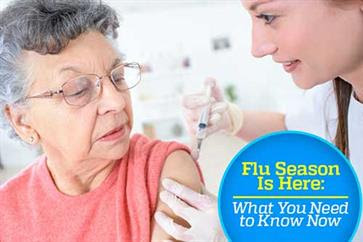Coming down with the flu is usually a miserable experience. The fever and chills, cough, pain, and fatigue that can last for a week or longer is certainly unpleasant for anyone, but for an older person, especially one with additional chronic conditions, the flu can actually be deadly.
According to the Centers for Disease Control and Prevention, last year there were 594 confirmed hospitalizations attributable to the flu between October 1, 2015 and January 1, 2016, with most of those patients over age 65. In most years, that number is even higher — and as many as 90 percent of all flu-related deaths are older adults. As we enter the 2016-2017 flu season, it’s important to be aware of a few important facts about the flu and educate your staff about what they can do to protect themselves and your clients.
CDC 2016-2017 Predictions
As always, the CDC is unable to predict what this year’s flu season will be like, and whether it will be better or worse than average. With that in mind, the agency recommends that everyone over 6 months of age get the flu vaccine to help protect against the virus. This is especially important for those working in the health care field, and many agencies and other providers have made flu shots mandatory for all employees.
As always, this year’s flu vaccine was developed based on the most prevalent flu viruses currently in circulation. These include:
- California/7/2009 (H1N1) pdm09-like virus
- A/Hong Kong/4801/2014 (H3N2)-like virus
- B/Brisbane/60/2008-like virus (B/Victoria lineage)
- B/Phuket/3073/2013-like virus (B/Yamagata lineage)
Given the predictive nature of the flu vaccine, it may not protect against all strains of the virus, and some individuals may still contract a different virus. However, health officials note that typically, even if an individual does get the flu after vaccination, it’s typically a milder case.
This year, the flu vaccine will be available in several different forms. Most people will receive the standard flu shot, but older adults may be given a shot with an adjuvant or a higher dose shot. In some cases, a shot made with a virus grown in a cell culture may be the best option, or a recombinant vaccine that was not made with the flu virus. In any case, the CDC does not recommend the nasal spray vaccine (Flu Mist) this year, as it is not expected to be as effective.
Why Vaccination Is Important
Flu vaccinations are an important tool in the fight against the spread of disease, but it’s also important to your agency in terms of ratings.
As part of CMS’ star-rating system for the quality of home health agencies released last year, the Home Health Compare Quality of Patient Care Star Ratings, one of the criteria is how often home health agencies ensured patients had the most current flu vaccine for the current flu season. While currently, home health reimbursements aren’t tied to the quality ratings, it is likely that in the future, performance on these measures could be tied to Value Based Payment plans and determine how much your agency receives for Medicare beneficiaries.
With that in mind, it’s best if your agency begins a flu vaccine program now. Not only do you need to provide flu vaccines to your employees, but develop a documentation system for ensuring that patients are up-to-date on their vaccines. Including that information in your patient records in your agency software program, and making notes about the immunization and flu education provided, ensures that no one “falls through the cracks” and that your agency meets its immunization goals.
Basic Flu Prevention
In addition to a vaccination plan, you should also provide additional training and education to your employees regarding flu prevention. Learn the signs of the flu, since getting medical attention within the first 48 hours can help lessen the duration of the illness. Some of the signs to watch for include fever, headache, extreme fatigue, cough, sore throat, runny nose, and body aches. Good hygiene habits can help prevent the spread of illness, including:
Washing hands regularly, and using an alcohol-based hand sanitizer when soap and water are not available
Coughing or sneezing into your elbow, or covering your mouth with a tissue and then immediately discarding it
Avoiding touching your face
Avoiding contact with people who are ill or showing the signs of the flu when possible.
If you must visit people who have symptoms, wear gloves and a face mask, and wash your hands thoroughly
- Staying home if you are sick or have the signs of the flu. Develop a plan within your agency to handle employee illness, including a rotating schedule of backups and a reasonable sick leave policy. Remind your employees that they should never feel that they should have to come to work ill.
By following these steps, you can help keep your staff and clients safe and healthy this flu season — and improve your quality ratings. For more information about software that can help you monitor immunizations and other important data, check out Complia Health’s family of products here.




